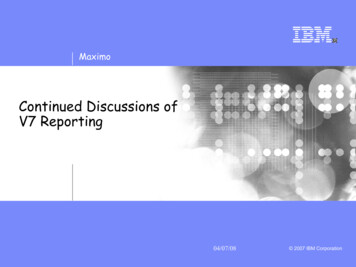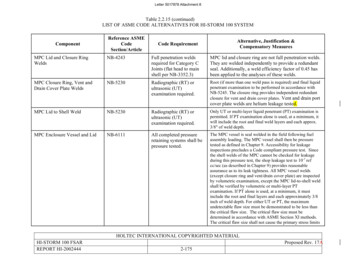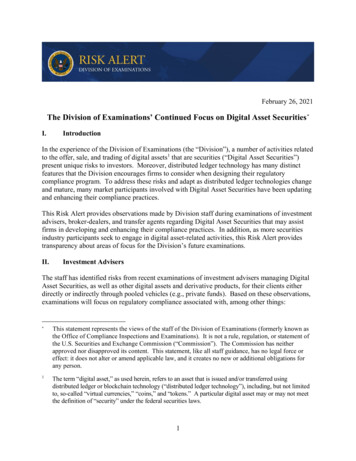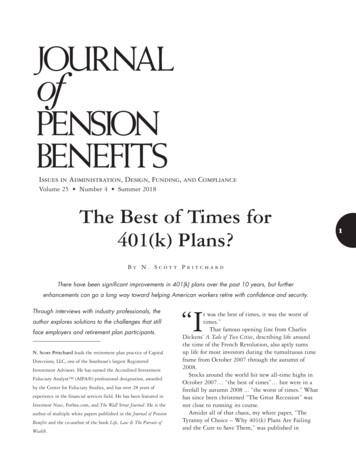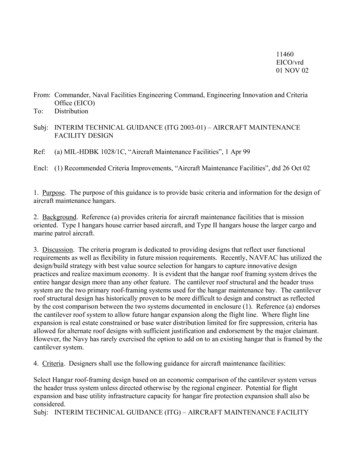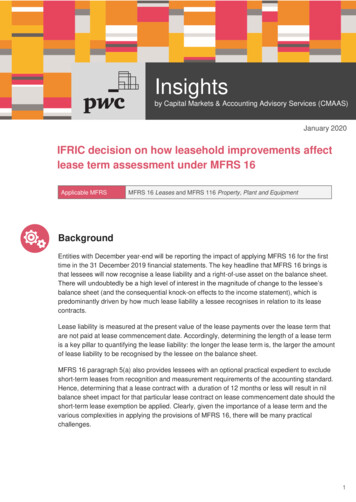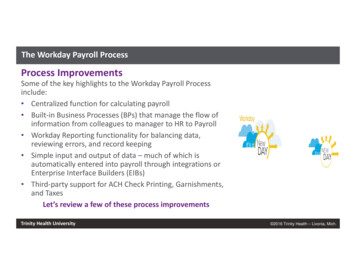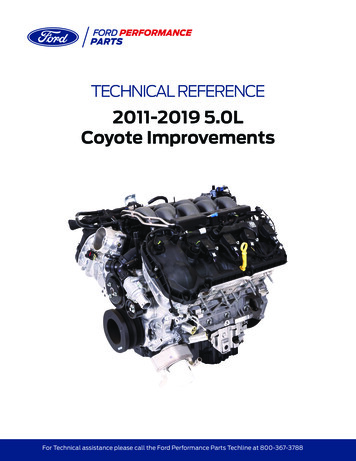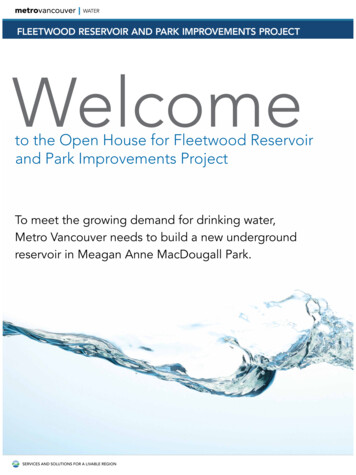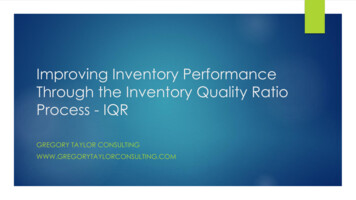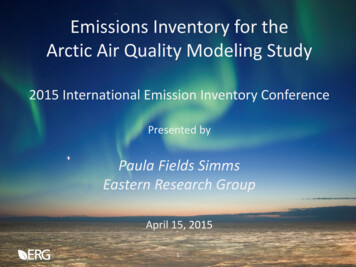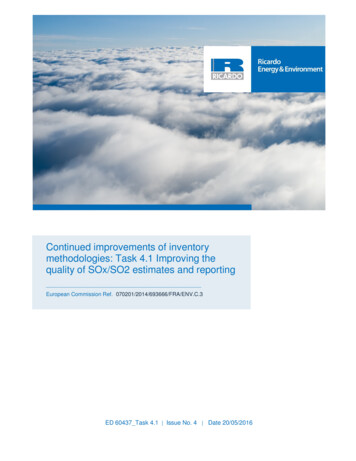
Transcription
Continued improvements of inventorymethodologies: Task 4.1 Improving thequality of SOx/SO2 estimates and reportingEuropean Commission Ref. 070201/2014/693666/FRA/ENV.C.3ED 60437 Task 4.1 Issue No. 4 Date 20/05/2016
Ricardo Energy & EnvironmentContinued improvements of inventory methodologies: Task 4.1 iCustomer:Contact:European CommissionDr Mark BroomfieldRicardo Energy & Environment, GeminiBuilding, Harwell, Didcot, OX11 0QR, UnitedKingdomt: 44 (0) 1235 75 3393e: mark.broomfield@ricardo.comCustomer ality, copyright & reproduction:This report is the Copyright of the EuropeanCommission and has been prepared by RicardoAEA Ltd under contract to The EuropeanCommission dated 05/12/2014. The contents ofthis report may not be reproduced in whole or inpart, nor passed to any organisation or personwithout the specific prior written permission of theEuropean Commission.Ricardo-AEA Ltdaccepts no liability whatsoever to any third partyfor any loss or damage arising from anyinterpretation or use of the information containedin this report, or reliance on any views expressedtherein.Ricardo-AEA Ltd is certificated to ISO9001 andISO14001Author:Chris Green, Maria Pooley, Will Smith, RobertWhiting (Amec Foster Wheeler), Chris Dore(Aether)Approved By:Mark BroomfieldDate:20 May 2016Ricardo Energy & Environment reference:Ref: ED60437 Task 4.1: Issue No. 4Ricardo Energy & EnvironmentRef: Ricardo/ED60437 Task 4.1/Issue No. 4
Ricardo Energy and EnvironmentTask 4.1 Improving the quality of SOX/SO2estimates and reportingMarch 2016Amec Foster Wheeler Environment& Infrastructure UK Limited
2 Amec Foster Wheeler Environment & Infrastructure UK LimitedReport forCopyright and non-disclosure noticeMark BroomfieldSpecialist ConsultantRicardo Energy and EnvironmentChadwick HouseBirchwood ParkWarringtonWA3 6AEThe contents and layout of this report are subject to copyrightowned by Amec Foster Wheeler ( Amec Foster WheelerEnvironment & Infrastructure UK Limited 2016) save to theextent that copyright has been legally assigned by us toanother party or is used by Amec Foster Wheeler underlicence. To the extent that we own the copyright in this report,it may not be copied or used without our prior writtenagreement for any purpose other than the purpose indicated inthis report. The methodology (if any) contained in this report isprovided to you in confidence and must not be disclosed orcopied to third parties without the prior written agreement ofAmec Foster Wheeler. Disclosure of that information mayconstitute an actionable breach of confidence or mayotherwise prejudice our commercial interests. Any third partywho obtains access to this report by any means will, in anyevent, be subject to the Third Party Disclaimer set out below.Main contributorsChris Dore (Aether)Chris GreenMaria PooleyWill SmithRobert WhitingIssued by.Robert WhitingApproved byThird-party disclaimerAny disclosure of this report to a third party is subject to thisdisclaimer. The report was prepared by Amec Foster Wheelerat the instruction of, and for use by, our client named on thefront of the report. It does not in any way constitute advice toany third party who is able to access it by any means. AmecFoster Wheeler excludes to the fullest extent lawfully permittedall liability whatsoever for any loss or damage howsoeverarising from reliance on the contents of this report. We do nothowever exclude our liability (if any) for personal injury ordeath resulting from our negligence, for fraud or any othermatter in relation to which we cannot legally exclude liability.Management systems.Chris GreenThis document has been produced by Amec Foster WheelerEnvironment & Infrastructure UK Limited in full compliance withthe management systems, which have been certified to ISO9001, ISO 14001 and OHSAS 18001 by LRQA.Amec Foster WheelerShinfield ParkReading RG2 9FWUnited KingdomTel 44 (0)118 9137318Doc Ref. 36581CRea001i3h:\projects\36581 pp ec aq inventory methodologies\c000client\deliverables\task 4.1 so2 vs SOX\finalreport\36581crea001i4 - task 4 1 sulphur oxidesreport final.docxMarch 2016Doc Ref. 36581CRea001i3Document revisionsNo.DetailsDate1Final version08/03/20162Final version with additional editsto ensure executive summaryand conclusion are fullyharmonised18/03/20163New Appendix added to includefurther discussion regarding thepolicy history for sulphurreporting05/05/20164Further minor changes to editorialcontent17/05/2016
3 Amec Foster Wheeler Environment & Infrastructure UK LimitedExecutive summaryThe emission of sulphur in various forms to air poses a threat to human health and the environment. Withinthe atmosphere sulphur forms sulphur oxides (SOX), which refers to many types of sulphur and oxygencontaining compounds, the two major ones being sulphur dioxide (SO 2) and sulphur trioxide (SO3). Thisincludes direct health effects upon humans above certain atmospheric concentrations of SO 2 and thepotential for acid deposition which can have negative effects upon the environment. This latter aspect raisedinternational recognition for the possibility of long-range transboundary effects of sulphur emissions incountries other than the point of emission. This issue particularly came to prominence in the 1970s with thephenomenon termed ‘acid rain’ which had a direct impact upon Scandinavian countries and emissions fromindustrial point sources in Western Europe.The air quality issues posed by sulphur are such that international action has been taken to mitigate them.This included the creation of the UNECE 1979 Convention on Long Range Transboundary Air Pollution(CLRTAP) and the formation of a series of protocols, including the 1999 Gothenburg Protocol, specifically toaddress sulphur and its environmental and health effects. In some cases there are specific provisions ofSO2 such as in CLRTAP (Article 8 Subparagraph a) on reporting SO2 emissions and for source-specific SO2limit values (e.g. the Gothenburg Protocol). At EU level there have also been moves to implement measuresto control and reduce the emissions of sulphur through the creation of the National Emission CeilingsDirective (NECD) (2001/81/EC). Salient to both CLRTAP and NECD is the need to estimate and report onemissions in order to assess progress towards emissions reduction. However an issue exists in the way that‘sulphur’ is calculated and reported under the CLRTAP and the NECD which poses an issue forcomparability and emissions gaps within reporting.The current study has reviewed and assessed the definitions, and magnitude of different forms of sulphur inmajor emission sources that would affect the international reporting carried out by Member States. TheNECD does not define ‘sulphur’ as such, but specifies reporting and emission targets for SO 2 only. Article 1of the Gothenburg Protocol defines ‘Sulphur’ as ‘all forms of sulphur expressed as sulphur dioxide (SO 2)’.This would suggest at face value that reporting and obligations of meeting the sulphur ceilings set out inannex II of the original Gothenburg protocol should include sulphur dioxide, sulphur trioxide (SO 3) and otherforms of sulphur emissions, including reduced sulphur. However, the specific emission limit values forsource categories set out in the Gothenburg Protocol annexes IV are set for SO 2 (not total sulphur), exceptfor the limit value for titanium oxide production in the 2012 amendment to the Protocol where the limit valueis set for SOX (expressed as SO2). It should here be noted that the protocols (or separate decisions of theCLRTAP) do not provide an explicit definition of SOX, thus it has been interpreted as the oxidised form ofsulphur or all forms of sulphur compounds depending on the circumstances.Additionally however, as the Gothenburg Protocol has evolved (latest version 2012), it has harmonised theelements of the Gothenburg Protocol with the NECD and other international legislation which is only SO 2focused.This means there is a lack of clarity with regard to whether “SO 2” means specifically sulphur dioxide, allforms of oxidised sulphur, or all forms of sulphur expressed as SO 2.A review of related legislation and major references open to inventory compilers suggested that the majorityof available reference material is focused specifically on SO 2. Along with the NECD, other EU legislationincluding the Ambient Air Quality Directive (2008/50/EC), Mechanisms for Monitoring and Reporting ofGreenhouse Gas Emissions (525/2013/EU) and Industrial Emissions Directive (2010/75/EU) all refer tosulphur dioxide only. In contrast the UNFCCC Kyoto Protocol and UNFCCC guidance for inventorycompilation, refer to sulphur as sulphur oxides, and are in that way different to the EU Mechanism forMonitoring and Reporting of Greenhouse Gas Emissions. The MARPOL Convention for internationalshipping refers to SOX throughout, but in setting compliance limits for emissions defers to the Internationalmaritime organisation (IMO) which uses only SO2. The Kiev Protocol of the Aarhus Convention on PollutantRelease and Transfer Registers (also transposed into the PRTR Regulation EC/166/2006) quotes SOX andSO2 interchangeably. The EMEP Corinair (now the EMEP/EEA) guidebook, which is the major reference forCLRTAP, refers to the NECD (SO2 only) and Gothenburg Protocol (all sulphur expressed as SO2), includingMarch 2016Doc Ref. 36581CRea001i3
4 Amec Foster Wheeler Environment & Infrastructure UK Limiteda section on the history of the guidebook. Emission factors within the guidebook are quoted as SOX to keepalignment with the 1999 Gothenburg Protocol.A review of the major emission sources reported by EU Member States 2010 to 2013 under the NECD andthe CLRTAP based on the Nomenclature for Reporting (NFR) index system shows a high level of correlation.While the main sources of emissions are broadly the same for LRTAP (SOX) and NECD (SO2) reporting,there are some differences in reported emissions and in the relative contribution of the sector. The mostnotable differences for reported emissions are for 1A3di(i) International maritime navigation, 1A2gviiiStationary combustion: Other and 1A2f Stationary combustion: Non-metallic minerals.Based on a review of the available literature the proportion of SO 2, SO3 and other forms of S within totalsulphur emissions have been assessed within the major point sources for combustion of fuels. This reviewindicated that for major point sources, SO2 represents 95% or greater of the total sulphur emission. Sourcesdo exist for emissions of sulphur from non-combustion point sources, such as refinery and iron and steelplant. While these sources will report under the Industrial Emissions Directive, less is known about the ratioof SO2 and SO3 within SOX.A review of other forms of sulphur potentially released from industrial processes was also carried out. Thisreflects the potential for emissions of a wide number of other species of sulphur which can contribute to theoverall sulphur budget. This includes: Hydrogen sulphide-H2S Methyl mercaptan-CH3SH Dimethyl sulphide-C2H6S Dimethyl disulphide-(CH3S)2 Carbon disulphide-CS2 Carbonyl sulphide-COS Sulphuric acid1-H2SO4 Sulphite/Hydrosulphite/Bisulphite-SO32- / HSO3- / S2O42-However, while a number of sulphur species other than SO2 can be emitted from point sources, the review ofliterature still suggests that the combined emission equates to less than 5% of the total sulphur emitted.The study has also assessed the effects of abatement technologies on the sulphur compounds ratios, andlikely implications for SO2, SO3 and other forms of S within the emission. Selective Catalytic Reduction(SCR) can increase in the amount of SO3 produced, due to the fact that as NOX is reduced to nitrogen andwater by the reaction with ammonia (NH3) in the presence of a catalyst, meaning that a small fraction of SO 2is oxidized to SO3. SO3 can be further converted through reaction with water into sulphuric acid (H 2SO4), oneof the other forms of sulphur mentioned, in the air heater of a power plant. Further guidance from CLRTAP2recognises that SO2 is created from the combustion of fuels containing sulphur, often in large point sources,while SO3 is created by oxidation during abatement processes. During Flue Gas Desulphurisation (FGD, thefinal stage of abatement before atmospheric release of emissions), wet lime/limestone scrubbers can remove92-98% of both SO2 and SO3, while dry limestone scrubbers can remove 85-92% of SO2 and 95% ofSO3.This would suggest that in the presence of FGD technologies, while the absolute concentration of SO 3 isreduced, the ratio of SO3:SO2 is driven more strongly towards SO2 in the presence of dry scrubbers than thefar more ubiquitously used wet scrubbers 3, but again, the overall sulphur emission is still dominated by SO 2at or greater than 95%.1S is not in a reduced state in H2SO4. While it may be removed by certain methods such as NCASI Method 8A, it is included herebecause it may not be captured by some SO2 measurement techniques.2UNECE, 2015, ‘Guidance document on control techniques for emissions of sulphur, nitrogen oxides, volatile organic compounds andparticulate matter (including PM10, PM2.5 and black carbon) from stationary sources’3European Commission. 2013. Integrated Pollution Prevention and Control BREF, Large Combustion Plants.March 2016Doc Ref. 36581CRea001i3
5 Amec Foster Wheeler Environment & Infrastructure UK LimitedThe conclusion of the study has identified that there is a compatibility issue in the ways that sulphurcompounds are recognised between CLRTAP and the NECD. However there is also a weight of supportinglegislation at EU level and internationally which strongly favours SO 2 as the recognised pollutant for emissionestimation and hence for compliance checking
quality of SOx/SO2 estimates and reporting . A review of related legislation and major references open to inventory compilers suggested that the majority of available reference material is focused specifically on SO 2. Along with the NECD, other EU legislation including the Ambient Air Quality Directive (2008/50/EC), Mechanisms for Monitoring and Reporting of Greenhouse Gas Emissions (525 .
